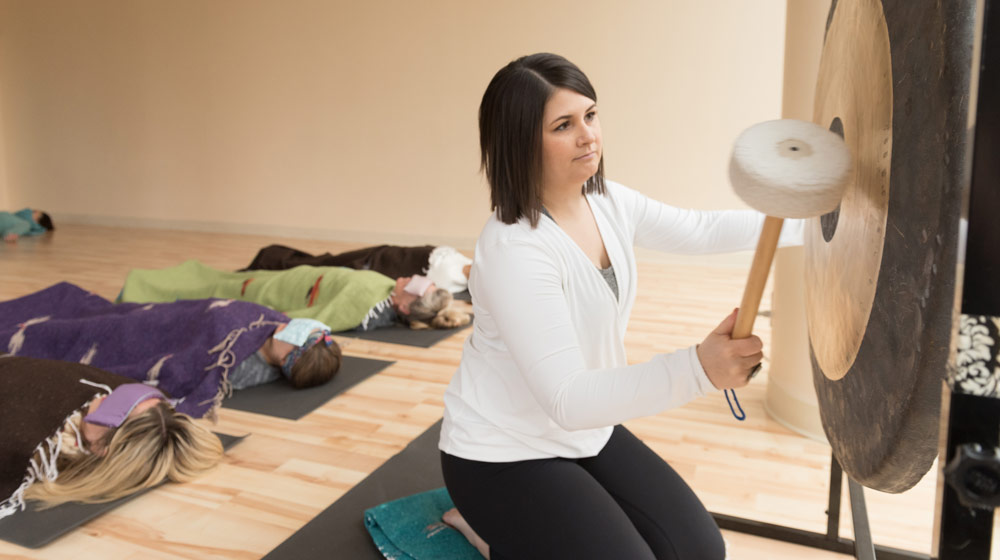Sink into a gong bath

“The gong is very simple. It is an inter-vibratory system. It is the sound of Creativity itself. The gong is nothing more, nothing less. One who plays the gong plays the universe. The gong is not an ordinary thing to play. Out of it came all music, all sounds and all words. The sound of the gong is the nucleus of the Word.”
— Yogi Bhajan
A gong bath truly is a transformative experience. To get a taste, start by imagining yourself lying in a dark room, on top of a yoga mat, covered in a blanket. Your palms face towards the sky and your eyes are closed. The teacher directs you to relax each part of your body one muscle at a time, from your toes to your tongue. The sound begins quietly at first and then slowly becomes louder and more rhythmic and trance-inducing. The vibrations wash over your body. Time seems to slip away and what feels like five minutes can really be 30. That is the power of a gong bath.
The gong is a traditional part of a Kundalini yoga practice. Yogi Bhajan, who brought Kundalini yoga to the West in 1968, asked that every Kundalini ashram and yoga center have a gong to be used regularly. Not only is the gong a musical instrument, but it is a healing tool. It releases blocks, reduces tension, simulates circulation and provides catharsis. It is not uncommon for people to cry, feel like they are in between awakeness and sleep, or to fall asleep completely during a gong bath. It can be a deeply emotional and personal experience.
“You have no resistance against this sound,” Bhajan once said. “It is the master sound, the adi naad. Everything you think becomes zero — the gong prevails.”
Before playing the gong, there are several mantras that you will either chant out loud as a class, or the teacher may choose to recite internally. Two of those mantras are the Bhakti mantra and the Mangalacharan mantra. The Bhakti mantra shows an appreciation for this moment and the gong while the Mangalacharan mantra gives peace and centeredness.
Bhakti Mantra
Ong Namo
I bow to the infinite creator of all
Guru Dev Namo
I bow to the divine subtle teacher who guides my soul
Mangalacharan Mantra
Ad Gurey Nameh
I bow/invoke the teacher who exists at the beginning
Jugad Gurey Nameh
I bow to the teacher who teaches through all times
Sat Gurey Nameh
I bow to the teacher who teaches from the truth
Siri Guru Dev A Nameh
I bow to the unseen subtle teacher of all
To produce the vibrations and sounds that make the gong so special, the player uses a specific technique. The gong is divided into three regions, each producing a different quality of sound. Different parts of the gong also correlate to the different chakras and can help open and balance the chakras.
A gong bath and meditation can be a class all on its own, or the gong can be played at the end of any Kundalini yoga class during Shavasana.
Since the moment I first learned how to play the gong, I have been drawn to its sound, its vibration and its benefits. Although my roots in the gong are through the Kundalini yoga tradition, a gong can be played and incorporated into any lineage or medium.
Whether it is experienced sitting up as part of a meditation or lying down as part of Shavasana, a gong bath is an amazing experience that I have shared with many and will continue to share throughout Iowa. Now close your eyes and imagine the sound waves washing over you.
Bridget Toomey, RYT-200, teaches Kundalini yoga at Heartland Yoga in Iowa City. She is a Reiki Master Practitioner and is currently pursuing her RYT-500 in the Kundalini tradition in Kansas City. Bridget is also working on her master’s degree in healthcare management though Johns Hopkins University. Follow her on Instagram: @IowaKundaliniYogini. This article was originally published in YogaIowa’s Winter 2018 issue.


